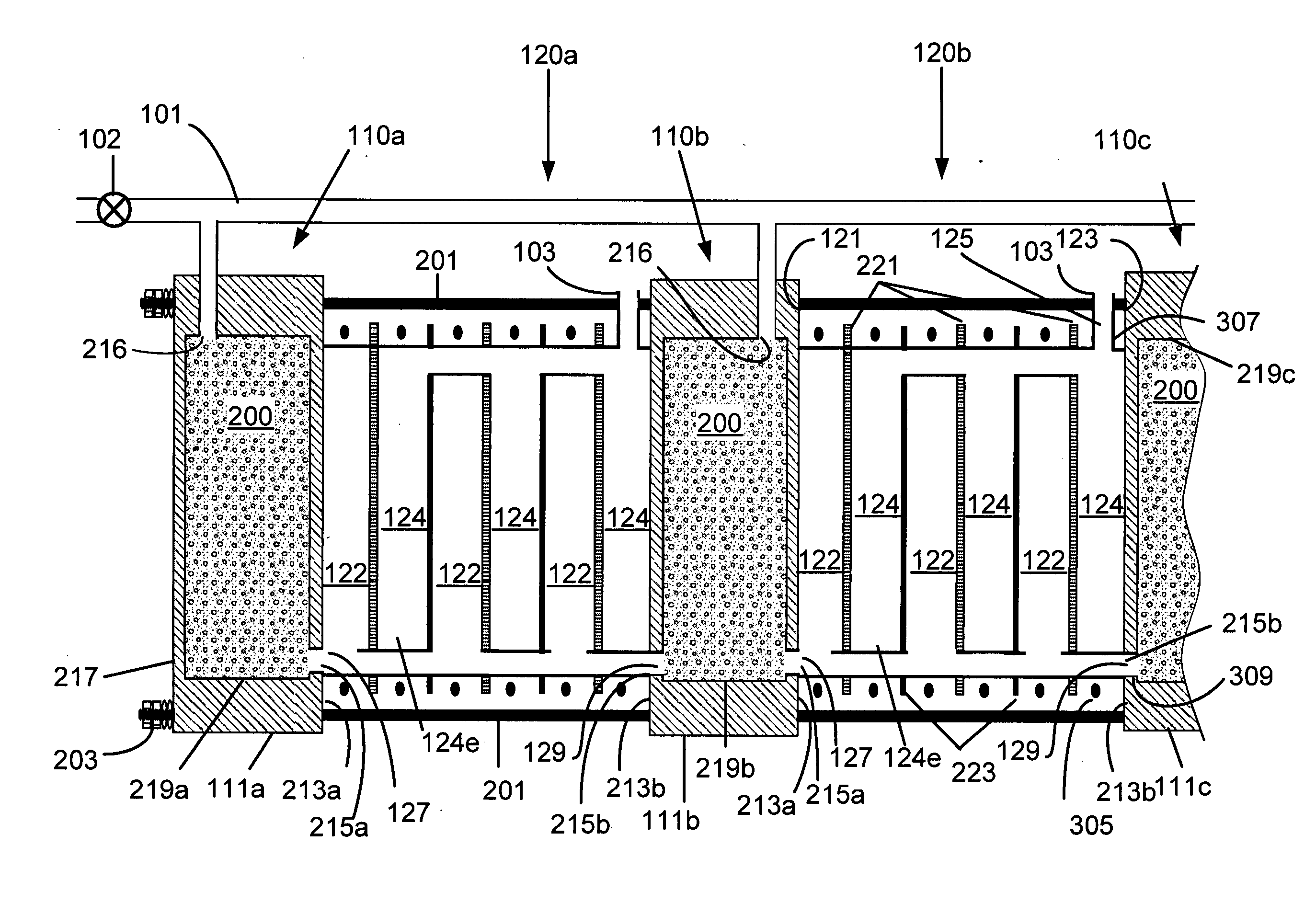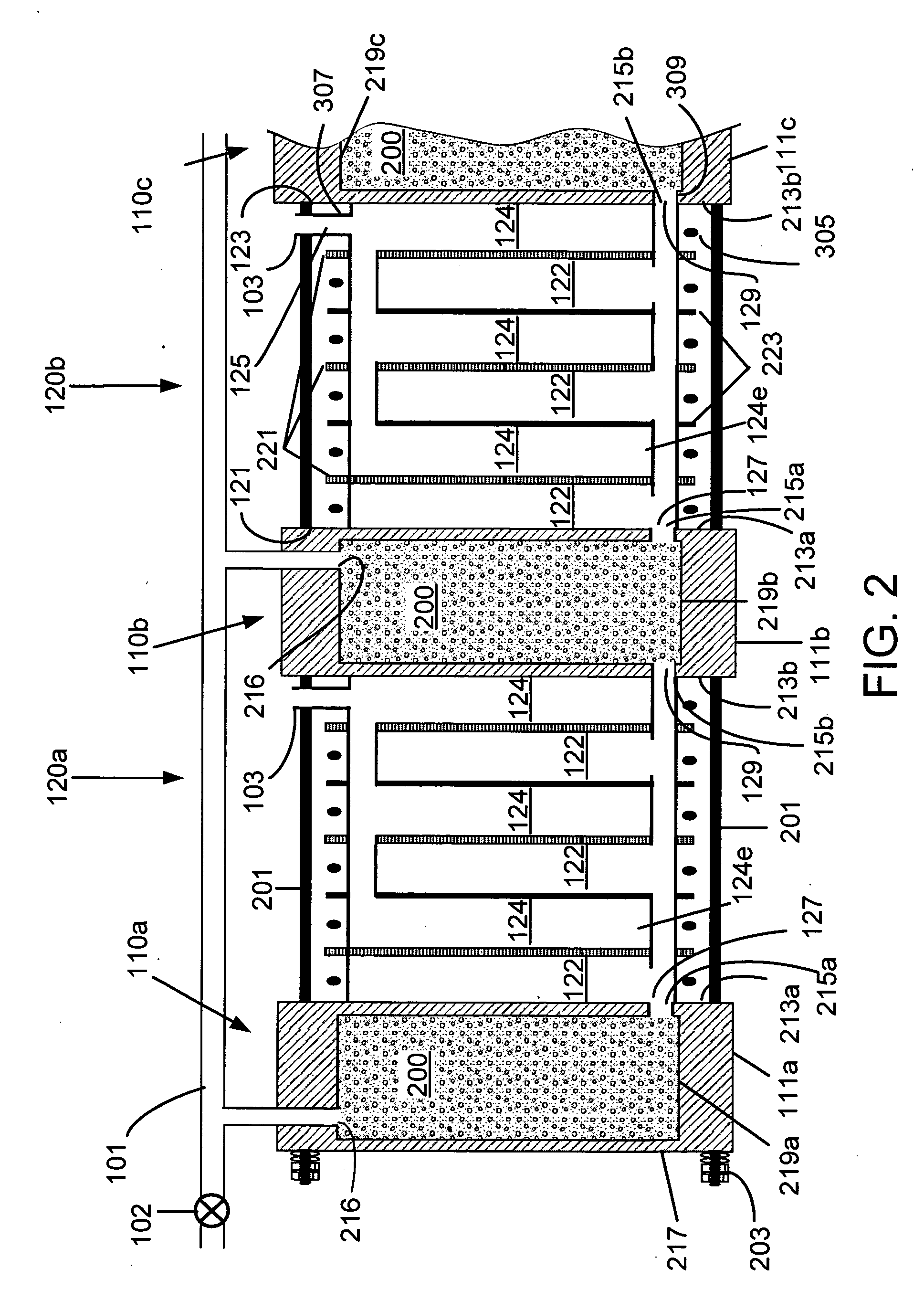Hydrogen storage and integrated fuel cell assembly
a fuel cell and hydrogen storage technology, applied in the field of hydrogen storage, can solve the problems of many tank materials not being able to stand up to hydrogen diffusion, flammability or explosion safety risks, and problems such as problems such as difficulty in ensuring the safety of the environment, and achieve the effect of improving heat transfer and easy replacement of materials
- Summary
- Abstract
- Description
- Claims
- Application Information
AI Technical Summary
Benefits of technology
Problems solved by technology
Method used
Image
Examples
first embodiment
[0040]FIG. 1 is a schematic perspective view of a first embodiment integrated hydrogen-powered electricity-producing system 100 of the present invention. System 100 includes hydrogen-storage assembly 10 and fuel cell assembly 20 and provides for electrical connections as an anode 107 and cathode 109. Hydrogen for system 100 is provided by a fuel supply line 101 to controllably provide hydrogen to fuel storage assembly 10, and the oxidizer for the system is provided by an oxidizer supply line 103. In one embodiment, the oxidizer is the oxygen in air, and that air under pressure is delivered to oxidizer supply line 103. Exhaust products from the reaction of fuel and oxidizer, principally water and waste or unused gases, are removed from system 100 through an exhaust line 105.
[0041] The flow of hydrogen gas from fuel supply line 101 into fuel storage assembly 10 is controlled by one or more valves 102. In one embodiment of the present invention, a single valve 102 controls the flow of ...
second embodiment
[0060] A second embodiment fuel storage unit 310 is shown in FIG. 3A as the sectional end view 3-3 of FIG. 1, in sectional end view FIG. 3B of the fuel storage unit without a material 200, in FIG. 4 as a top view 4-4, and in FIG. 5A as a top sectional view 5-5. Fuel storage unit 310 may, in various embodiments, be generally similar to any one or more of the embodiments of fuel storage unit 110 disclosed herein, except as further discussed below, and may be used to provide hydrogen to fuel cell stacks 120, as described herein. Fuel storage unit 310 has volume 219 in housing 111 which includes several cylindrical volumes 303 each having a cover 301 and connected by passageways 305. As is shown in FIGS. 3A, 3B and 5A, passageways 305 connect volume 219 to inlet 216 and outlet 215, and includes passages 304 that connect cylindrical volumes 303, a passage 302 that extends to inlet 216 and a passage 306 that extends to outlet 215. The partitioning of volume 219 into smaller volumes 303 al...
third embodiment
[0062] A third embodiment fuel storage unit 310′ is shown in the FIG. 5B as a top sectional view 5-5 of FIG. 3A. Fuel storage unit 310′ may, in various embodiments, be generally similar to any one or more of the embodiments of fuel storage units 110 or 310 disclosed herein, except as further discussed below, and may be used to provide hydrogen to fuel cell stacks 120 as described herein. Fuel storage unit 310′ has volumes 303 with two different hydrogen-storage materials, indicated as material 200-1 and material 200-2, with a different set of interconnections for each. Thus each volume 303 containing material 200-1 is connected to the hydrogen supply through a passageway 302-1 and to an outlet 215-1 through a passageway 306-1. Each volume 303 containing material 200-2 is connected to the hydrogen supply through a passageway 302-2 and to an outlet 215-2 through a passageway 306-2. Preferably each passageway 302-1 and 302-2 has a controllable valve to allow the flow of hydrogen into t...
PUM
| Property | Measurement | Unit |
|---|---|---|
| pressures | aaaaa | aaaaa |
| temperature | aaaaa | aaaaa |
| temperatures | aaaaa | aaaaa |
Abstract
Description
Claims
Application Information
 Login to View More
Login to View More - R&D
- Intellectual Property
- Life Sciences
- Materials
- Tech Scout
- Unparalleled Data Quality
- Higher Quality Content
- 60% Fewer Hallucinations
Browse by: Latest US Patents, China's latest patents, Technical Efficacy Thesaurus, Application Domain, Technology Topic, Popular Technical Reports.
© 2025 PatSnap. All rights reserved.Legal|Privacy policy|Modern Slavery Act Transparency Statement|Sitemap|About US| Contact US: help@patsnap.com



